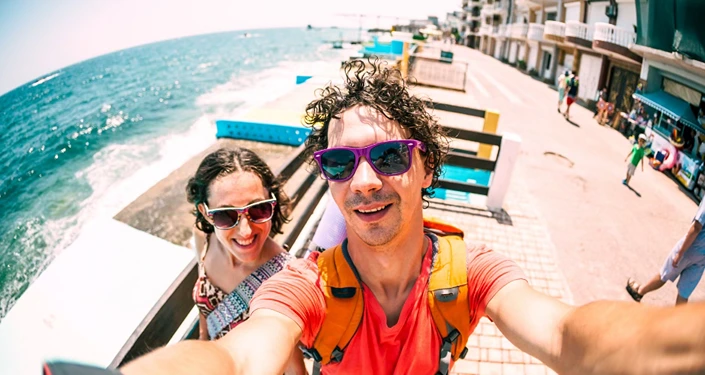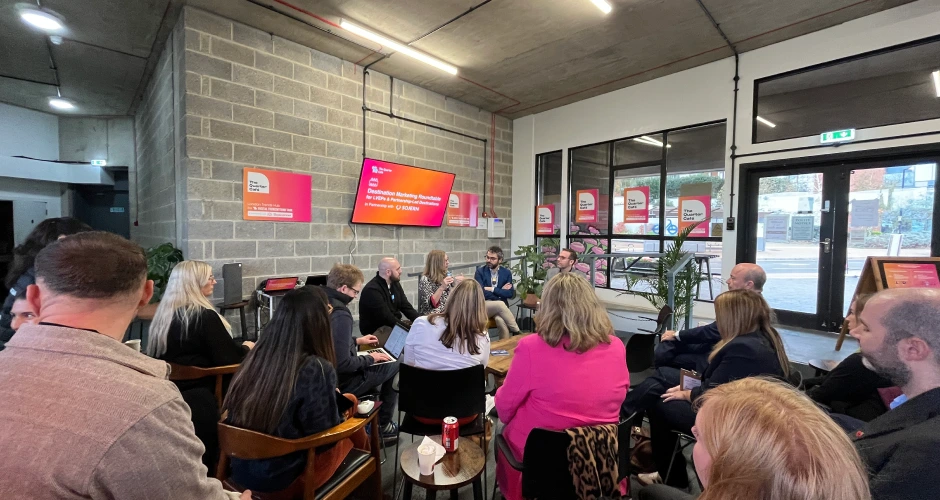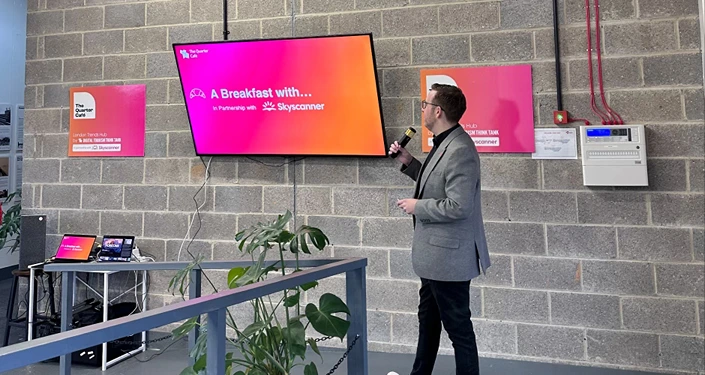In episode 9 of our "Tour Tech: Your 5 Weekly Takeaways to Tourism Success" podcast series, part of the EU-funded Tourbit project, we learn how digitalisation supports backend business operations and the importance of effective design and sustainability in glamping experiences. This article explores digital task management systems, communication methods and how ChatGPT can be a tool that supports businesses, focusing on Lushna, a designer of cabins for tourist destinations, and Camping Sass Dlacia. By examining their approaches, we gain insights into how digital solutions can empower businesses to succeed while staying true to their core values.
Designing Glamping Experiences
Peter Licen, CEO & Design Principal at Lushna, explains how the company creates unique guest experiences that allow immersion in nature with minimal environmental impact. The company achieves this by focusing on two key areas: sustainable construction and fostering a connection with nature. Central to this process is achieving a balance between openness to nature and privacy as well as comfort and security within the cabins.
Lushna's cabins are designed to blend seamlessly into the natural environment. This focus on sustainability reflects a growing trend within the hospitality industry, where guests are increasingly seeking eco-friendly experiences. Peter emphasises the importance of creating a unique appeal and developing destinations out of an existing identity rather than rushing to follow trends that will likely become outdated in the not-too-distant future. Thomas Wieser, CEO of Camping Sass Dlacia, shares how by focusing on experiences, not just overnight stays, the campsite achieved a 78% occupancy rate in the first month of operation, successfully attracting influencers who create additional visibility for the company through Instagram Reels.
Digital Transformation of Business Operations
Finding the right digital tools is crucial for both companies. Peter and Thomas acknowledge that simply adopting the most popular software might not be the most effective approach. Instead, they advocate for identifying tools that cater to their specific needs. This ensures that digital solutions truly empower their operations rather than creating unnecessary complexity.
Both Lushna and Camping Sass Dlacia leverage digital tools extensively. Peter explains that Lushna uses technology to speed up the production process through an industrialised approach to making cabins while still leaving room for small adaptations to suit the specific requirements of each campsite. These pre-fabricated units are then constructed on-site, allowing for faster turnaround times and greater efficiency in cabin creation. Technology is also utilised for digital prototyping to develop and test ideas and to show Lushna's customers how the cabins will be implemented in their destination, helping visualise the final product and facilitating two-way communication about the best approach to ensure quality experiences with limited impact on the destination's ecology. Prototyping also enables the early identification of errors and the design of cost-effective ways to quickly rectify them.
Thomas emphasises the importance of investing in technology and how it has helped Camping Sass Dlacia provide a better level of service to visitors and grow faster - with average annual growth rates of 30%. Camping Sass Dlacia utilises widgets on its website linked to the booking engine and the various activities sold through the platform. Through having a well-developed website, the company has been able to eliminate the need for printed material, with all information available online for visitors.
Despite hospitality being about human interaction, Thomas explains how digital tools support backend operations for a variety of tasks. For example, Camping Sass Dlacia uses Connecteam for staff to schedule their work hours and holidays and Asana for task management, with technology also enabling staff to undertake training. Property Management Systems (PMS) and Enterprise Resource Planning (ERP) systems are also crucial for managing customer interactions.
Notably, both Peter and Thomas explain how they are experimenting with artificial intelligence (AI) tools, such as ChatGPT. In the case of Camping Sass Dlacia, the application of AI to manage communication flows with potential guests has significantly reduced the time for multi-lingual social media content creation. Meanwhile, Peter explains that ChatGPT has helped improve his response times for emails, improving productivity by a day. As AI continues to develop, machine learning will enable this technology to support more areas of their businesses and further improve operational efficiency.
Collaboration and Communication in a Digital Age
While digital tools play a significant role in operations, both Peter and Thomas emphasise the importance of human connection. Lushna fosters a collaborative environment where everyone from architects to construction workers feels involved in the design process, spending a week together on location in the planning phase to get a better understanding of the natural environment and the local community at the destination. Building upon this, Lushna recognises the importance of simple communication flows. The company utilises a lean management approach, implementing Workflowy to ensure everyone involved in a project stays informed and has the opportunity to contribute, enabling faster and more effective communication. This collaborative approach allows for the exchange of creative ideas to develop better solutions, where everyone works together as partners to achieve a successful outcome.
Camping Sass Dlacia fosters a similar approach to building a strong company culture by encouraging employees to share their ideas and contribute to the business's success. Thomas emphasises that employees are motivated by specific projects and the value that they can add to them. By taking a more collaborative approach to management, staff have space to grow and further develop their skills, helping to build the motivated and engaged workforce required for success. This is why digital management tools that easily facilitate collaboration and communication are an essential aspect of operations that must not be overlooked, where technology acts as an enabler of human relationships and interactions.
Key Takeaways
Design is a crucial component in creating exceptional visitor experiences. Destinations must have unique identities to create clear differentiation, facilitating the potential for attracting a social media buzz. Meanwhile, an agile and lean management approach helps to align everyone around common goals and values. It also enables the exchange of diverse perspectives to combine knowledge from different fields, leading to the most efficient and effective outcome being implemented. Taking an active interest in employees’ careers and understanding their aspirations only strengthens the process, building a strong commitment to project outcomes amongst all team members.
Nevertheless, digitalisation can cause paradoxes when designing nature-based experiences, where visitors want to immerse themselves in natural surroundings and minimise their daily usage of technology. However, as Lushna and Camping Sass Dlacia exemplify, digital solutions can be seamlessly integrated into the background to ensure smooth operations. This necessitates a selective approach to the use of technology, where clear business needs must be identified and the right tool selected after careful assessment of the plethora of available tools to find the right fit for a business and its organisational culture.
Experimentation is also crucial, where emerging technologies present new opportunities for improving efficiency and productivity. This is clearly observable from the time saved by both Lushna and Camping Sass Dlacia by using ChatGPT to streamline different aspects of their communication needs. With continued improvements to machine learning algorithms, such tools are likely to only become more important in the future.
Here are the five key takeaways:
- Being sustainable-first, just as much as we advocate digital-first, is a key differentiator for any business.
- Great technology drives businesses forward; not only in facilitating bookings, but also in driving the entire communication flow and project management.
- Digital tools can create transparency and expediency in communication within and amongst teams and enable empathy when building prototypes that facilitate product optimisation.
- Design matters in user experience and is a key part of enhancing competitiveness.
- Whilst generative AI is still in its very early stages, it’s clear that its impact on maximising operational efficiencies will be profound and enable companies to maximise their potential output.
The podcast is part of the Tourbit project, co-funded by the EU's COSME programme, with the support of the Catalan Tourist Board, Barcelona Chamber of Commerce, Paris&Co, Arctur Doo, Hub Brussels, Iceland Tourism Cluster, Lapland University of Applied Sciences and NEST - Tourism Innovation Center.






.svg)
















.webp)
